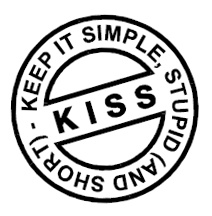
#WriteTip The Art of Keeping It Simple #writers #writing #amwriting
 Keep it Simple, Silly
Keep it Simple, Silly
By Jen Matera. Reposted with permission from Write Divas
KISS: Keep It Simple, Silly. That’s a cleaned-up version of a mantra most of us have heard time and time again. Keep it simple. And I’d never call anyone… well, you know. So silly works better for me.
I find I use the word simplify rather often in my notes to authors, and it struck me that this could be a good topic for an article on writing.
When you’re an author looking at a manuscript I’ve made bleed with my red pen, you probably understand “simplify,” but when an editor says “simplify,” you may wonder how do to do that? Here are some things writers can do to simplify and streamline their work.
Minimize unnecessary details
1) At a sentence level:
Redundancy can and does happen to everyone, and sometimes authors don’t even realize things are redundant until they are pointed out. Take, for example, the sentences below.
“Sure,” Emily said, nodding her head.
Don’t let the children on the playground outside.
At a first glance, neither sounds bad—or even full of unnecessary details. But consider the first sentence. What can you nod beside your head? Not much, so the words her headaren’t needed. To streamline even further, take away the tag completely.
In the same context, sentence number two is pretty obvious now, isn’t it? Most playgrounds are outside, so it’s not really necessary to say so. Consider each word you use. Do you need it?
2) And at a paragraph level:
Countless times I’ve read a book or a manuscript that’s got every detail of a room laid out for the reader or a character’s clothes expressly described, right down to fabric. And brand name. Unless your character is a clothing designer, or said designer clothing, each article, and its description will matter later in your manuscript, take it out. Does it matter that Mary Sue is wearing a lavender Whatsit skirt with matching blouse and Whoosit shoes? Unless the cops need that level of description to identify the body when they pull it out of the lake, it doesn’t matter. And honestly, if you need to establish wealth, find another way. Brand name dropping over and over isn’t necessary at all. Consider your level of detail with each description you write.
3) And at a scene level:
Characters eat. They drink. They go grocery shopping. They take showers. They get dressed. They work. But scene after scene of this just weighs a story down. Sometimes the mundane is there for a reason. The reader needs to see that the characters live a normal life, a boring life, a whatever kind of life. But when the reader gets to the end and looks back, thinking “what was all that about?” you need to reconsider the level of detail you’re writing to. Each scene in your book should move your story forward, either in story line or in time. If it doesn’t, copy it to your “cuts” file and move on to the next one.
Reconsider your word choice
The English language is vast and the number of words available to the author today isn’t even quantifiable. So when authors choose to use the words run quickly across the streetwhen they could easily say dash, I’m baffled. Get rid of adverbs and adjectives and reconsider your nouns and verbs. Don’t take your words for granted. Make each one count.
Get rid of useless and pointless dialogue tags
I’ve said this before, but it bears repeating. He said and she said are just fine as tags and are my tags of choice because they become invisible after a while. However, when there is clear and distinct action that lets the reader know who’s speaking, redundant tags just trip me up. Put informative and useful action around your dialogue that helps the reader understand not only who’s speaking, but how. And you’ll never need a pointless he saidor she said again.
I’m sure there are countless other ways to simplify your writing, and I’d love to hear your ideas. So leave a comment with your best ones!